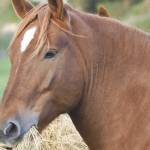What’s Inside the Horse’s Head?

The bones of the equine skull are arranged to contain the cranial, orbital, oral, and nasal cavities. Within the cranial cavity are the brain and several sense organs. The orbital cavity surrounds the eyes and protects them from injury.
The oral cavity allows the passage of ingested food into the horse’s digestive tract. The nasal cavity leads into the respiratory system, and includes extensive sinuses, or air-filled chambers. There are six sets of sinuses, some of which have several sectors.
The skull is made up of 34 large and small bones, of which 14 are the major pieces. Among these are the frontal bone that shapes the horse’s forehead; the parietal bone that sits between the frontal bone and the rear of the skull; the incisive, maxillary, and mandible that form the jaws; and the occipital that forms the joint between the skull and the atlas, or first vertebra. Other bones of the skull are the palatine (hard palate), vomer (top of the nasal cavity), and zygomatic (cheek bone).
The skull structure is designed to allow support and protection to the brain, nerves, and blood vessels as well as other structures such as the eyes. Various bones are subject to bruising or fracture if the horse is kicked or encounters other trauma. One of the most dangerous injuries can happen when a horse flips over backward, hitting its head against the ground or another hard surface such as a curb or pavement. This impact can fracture the sphenoid at the base of the skull, an injury that is often fatal.








